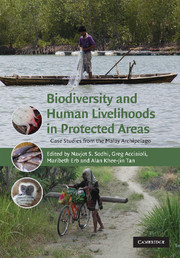Book contents
- Frontmatter
- Contents
- List of contributors
- Acknowledgements
- 1 General introduction
- Part I Conservation needs and priorities
- Part II Conservation with and against people(s)
- 11 Introduction to Part II
- 12 Collaboration, conservation, and community: a conversation between Suraya Afiff and Celia Lowe
- 13 Hands off, hands on: communities and the management of national parks in Indonesia
- 14 Conservation and conflict in Komodo National Park
- 15 Another way to live: developing a programme for local people around Tanjung Puting National Park, Central Kalimantan
- 16 For the people or for the trees? A case study of violence and conservation in Ruteng Nature Recreation Park
- 17 Seas of discontent: conflicting knowledge paradigms within Indonesia's marine environmental arena
- 18 Strategy and subjectivity in co-management of the Lore Lindu National Park (Central Sulawesi, Indonesia)
- 19 Indigenous peoples and parks in Malaysia: issues and questions
- 20 Protecting Chek Jawa: the politics of conservation and memory at the edge of a nation
- 21 Integrating conservation and community participation in protected-area development in Brunei Darussalam
- 22 Conclusion to Part II
- Part III Legal and governance frameworks for conservation
- 29 General conclusion
- Index
- References
16 - For the people or for the trees? A case study of violence and conservation in Ruteng Nature Recreation Park
from Part II - Conservation with and against people(s)
Published online by Cambridge University Press: 12 November 2009
- Frontmatter
- Contents
- List of contributors
- Acknowledgements
- 1 General introduction
- Part I Conservation needs and priorities
- Part II Conservation with and against people(s)
- 11 Introduction to Part II
- 12 Collaboration, conservation, and community: a conversation between Suraya Afiff and Celia Lowe
- 13 Hands off, hands on: communities and the management of national parks in Indonesia
- 14 Conservation and conflict in Komodo National Park
- 15 Another way to live: developing a programme for local people around Tanjung Puting National Park, Central Kalimantan
- 16 For the people or for the trees? A case study of violence and conservation in Ruteng Nature Recreation Park
- 17 Seas of discontent: conflicting knowledge paradigms within Indonesia's marine environmental arena
- 18 Strategy and subjectivity in co-management of the Lore Lindu National Park (Central Sulawesi, Indonesia)
- 19 Indigenous peoples and parks in Malaysia: issues and questions
- 20 Protecting Chek Jawa: the politics of conservation and memory at the edge of a nation
- 21 Integrating conservation and community participation in protected-area development in Brunei Darussalam
- 22 Conclusion to Part II
- Part III Legal and governance frameworks for conservation
- 29 General conclusion
- Index
- References
Summary
Introduction: environmental degradation and ‘green-war’
[T]he concept of ‘green-war’ – in its ideological circulation and strategic deployment – may itself fuel conflicts rather than assist in defining policies to address them.
(James Fairhead, 2001, in Violent Environments, pp. 214–215.)Apocalyptic forecasts about the state of the planet have been increasing for some time now. Peluso and Watts (2001), in a recent collection of essays assessing the relationship between environmental degradation and violence, attempt to criticize and eschew some of the simplistic formulas that have been emerging, where scarcity will ultimately lead to genocide, a phenomenon named ‘greenwar’ by some scholars (Bennett 1991). These apocalyptic visions have increasingly informed matters of international security and politics most particularly since the end of the cold war (Peluso & Watts 2001:4). The journalist Robert Kaplan's (1994) influential article, ‘The coming anarchy: how scarcity, crime, overpopulation, and disease are rapidly destroying the social fabric of our planet’, was just one of the more influential of the catalysts to this mounting doomsday vision (Peluso & Watts 2001:1; Rimmerman 1998:284–289). Perhaps the most disturbing outcome of these growing fears is how the solutions proposed seem to, with only passing regret, champion the rise of elite rule, empire and authoritarian control (Rimmerman 1998:285); in other words the era of liberal democracy itself must be doomed, if we want to save the planet. Despite rhetoric to the contrary, one can see that this is in fact what has been happening in the post-cold war era.
- Type
- Chapter
- Information
- Biodiversity and Human Livelihoods in Protected AreasCase Studies from the Malay Archipelago, pp. 222 - 240Publisher: Cambridge University PressPrint publication year: 2007



